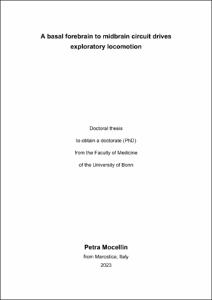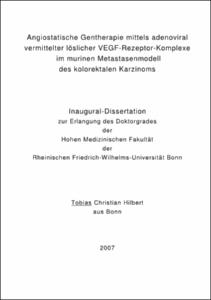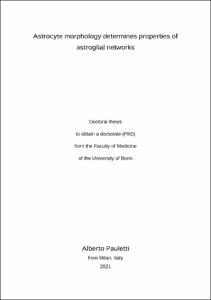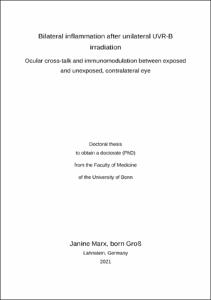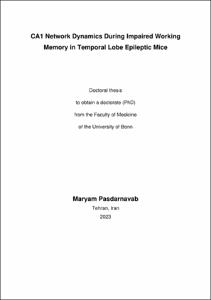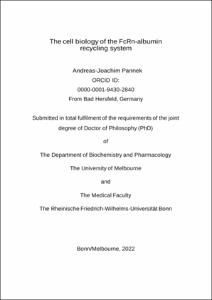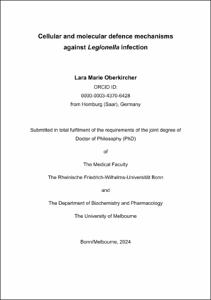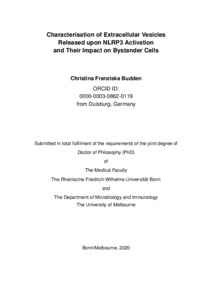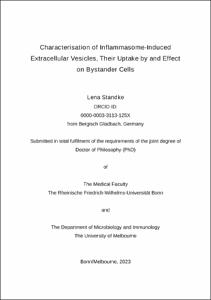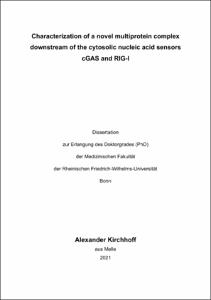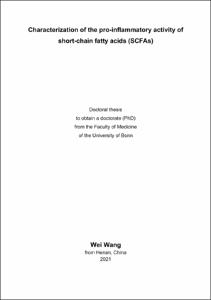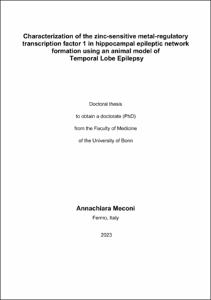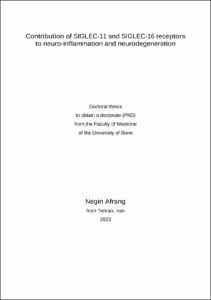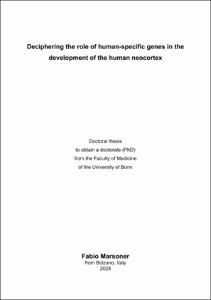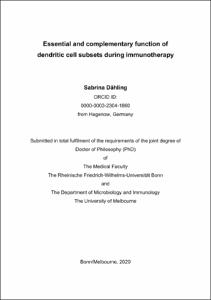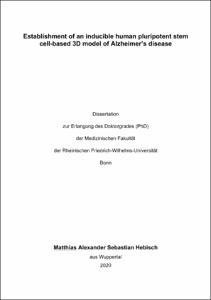E-Dissertationen: Browsing E-Dissertationen by Classification (DDC) "ddc:570"
Now showing items 1-20 of 88
-
A basal forebrain to midbrain circuit drives exploratory locomotion
Mocellin, Petra (2023-10-26)Locomotion is a fundamental behavior that comprises different specialized neuronal networks. In the basal forebrain, the glutamatergic neurons of the medial septum and diagonal band of Broca (MSDB<sub>glu</sub>) can initiate ... -
Aktivierung des angeborenen Immunsystems im Zentralnervensystem nach subchronischer Alkoholbehandlung im Mausmodell
Rath, Jule Marie (2020-06-03)Alkohol ist als kulturell anerkanntes Rauschmittel in seinen ökonomischen, sozialen und gesundheitlichen Risiken weiterhin unterschätzt. In der Literatur zeigen sich Hinweise auf die Relevanz unterschiedlicher Trinkmuster ... -
Angiostatische Gentherapie mittels adenoviral vermittelter löslicher VEGF-Rezeptor-Komplexe im murinen Metastasenmodell des kolorektalen Karzinoms
Hilbert, Tobias Christian (2007)EINLEITUNG: Das kolorektale Karzinom (CRC) stellt in der westlichen Welt sowohl bei Männern als auch bei Frauen die zweithäufigste Tumorentität dar. Die Bildung metastatischer Absiedelungen unter anderem in der Leber ... -
Astrocyte morphology determines properties of the astroglial networks
Pauletti, Alberto (2021-09-29)Astrocytes are very abundant glial cells in the brain. They perform many functions: provision of nutrient to the neurons, maintenance of extracellular ion balance, shaping of network operations and synaptic signaling and ... -
Bilateral inflammation after unilateral UVR-B irradiation: Ocular cross-talk and immunomodulation between exposed and unexposed, contralateral eye
Marx, Janine (2021-01-29)The presented study investigates the influence of exposure of one eye to UVR-B on the unexposed, partner eye in vivo in a mouse model. Furthermore, we try to answer the question whether this sympathizing reaction of the ... -
CA1 Network Dynamics During Impaired Working Memory in Temporal Lobe Epileptic Mice
Pasdarnavab, Maryam (2023-06-12)Around 50 million people worldwide suffer from epilepsy. Seizures are not the only feature of epilepsy that patients suffer from. Despite the fact that other comorbidities of epilepsy such as memory deficits widely impact ... -
The cell biology of the FcRn-albumin recycling system
Pannek, Andreas-Joachim (2022-08-10)Human serum albumin (HSA) is the most abundant protein in plasma and has an exceptionally long circulatory half-life of around three weeks in humans. The enhanced half-life properties of HSA result from the selective ... -
Cellular and molecular defence mechanisms against Legionella infection
Oberkircher, Lara Marie (2024-01-26)The two most prevalent causes of Legionnaires’ disease are <em>L. pneumophila</em> and <em>L. longbeachae</em>. The rising incidence of the Legionnaires’ disease over the past two decades together with the increasing ... -
Characterisation of Extracellular Vesicles Released upon NLRP3 Activation and Their Impact on Bystander Cells
Budden, Christina Franziska (2020-02-17)Inflammasomes are cytosolic multi-protein complexes that assemble upon detection of danger signals of infectious or sterile origin. Activation of the NOD-like receptor NLRP3 results in activation of caspase-1, which ... -
Characterisation of Inflammasome-Induced Extracellular Vesicles, Their Uptake by and Effect on Bystander Cells
Standke, Lena (2023-12-22)Inflammasomes are multimeric complexes whose activation triggers caspase 1 cleavage resulting in processing of the cytokines interleukin (IL) 1β and IL-18, and the pore-forming protein gasdermin D. This, in turn, initiates ... -
Characterization of a novel multiprotein complex downstream of the cytosolic nucleic acid sensors cGAS and RIG-I
Kirchhoff, Alexander (2021-08-30)Detection of viral nucleic acids by specialized PRRs of the innate immune system triggers the expression of type I IFNs, a hallmark of antiviral defense. In vertebrates, the cGAS-STING pathway and the RLR-MAVS pathway have ... -
Characterization of the pro-inflammatory activity of short-chain fatty acids (SCFAs)
Wang, Wei (2021-10-13)Short-chain fatty acids (SCFAs), which are mainly derived from microbial fermentation of dietary fibres, have been considered to be beneficial to gut health for decades. Recently, a few of studies reported that some patients ... -
Characterization of the zinc-sensitive metal-regulatory transcription factor 1 in hippocampal epileptic network formation using an animal model of Temporal Lobe Epilepsy
Meconi, Annachiara (2023-10-02)Temporal lobe epilepsy (TLE) is the most common form of focal epilepsy. It usually occurs after a transient brain insult, including status epilepticus (SE), which triggers a latent period of epileptogenesis prior to the ... -
Chronic Helminth Infection Ameliorates Colitis via ***** regeneration program
Kazakov, Alexander (2022-03-07)(noch nicht zugänglich / not yet accessible) -
Contribution of SIGLEC-11 and SIGLEC-16 receptors to neuro-inflammation and neurodegeneration
Afrang, Negin (2023-02-14)Brain aging is a multifactorial process including accumulation of aged lipids and proteins, neuroinflammation and loss of neurons. SIGLEC-11 and SIGLEC-16 are paired opposite inhibitory- versus activatory-signaling ... -
Deciphering the role of human-specific genes in the development of the human neocortex
Marsoner, Fabio (2024-01-04)The human brain is remarkably complex and has been subject to noteworthy changes throughout evolution. An expansion of progenitor cells is thought to contribute to the complexity and increase in cortical size that is ... -
Development of a CRISPR/Cas9 based RiboTag strategy to identify regulators of melanoma immune interaction
Kretzmer, Freya Maria (2023-11-09)The development of immunotherapy approaches has revolutionised the field of melanoma treatment by prolonging the survival of patients. Nevertheless, a significant proportion of patients either do not respond to immunotherapy ... -
Einfluss der Cyclin-abhängigen Kinase 5 auf die Expression des Programmed Cell Death Ligand 1 in murinen Pankreaskarzinomen im Vergleich verschiedener Analysemethoden
Mann, Marcel (2023-03-23)<strong>Einleitung:</strong> Programmed Cell Death Ligand 1 (PD-L1) ist ein immuninhibitorisches Molekül, das für gewöhnlich von bestimmten Immunzellen oder dendritischen Zellen exprimiert wird. Auch verschiedene Tumoren ... -
Essential and complementary function of dendritic cell subsets during immunotherapy
Dähling, Sabrina (2020-03-11)T lymphocytes are critical components of the adaptive immune system that protects us against a variety of infections. However, during chronic infections such as with HIV, HCV and HBV as well as cancers, T cells become ... -
Establishment of an inducible human pluripotent stem cell-based 3D model of Alzheimer's disease
Hebisch, Matthias Alexander Sebastian (2020-11-16)Alzheimer’s disease (AD) is the most prevalent neurodegenerative disease in the aged population. The vast majority of cases are sporadic, however, various mutations may cause early-onset, familial AD (FAD) variants. AD is ...


